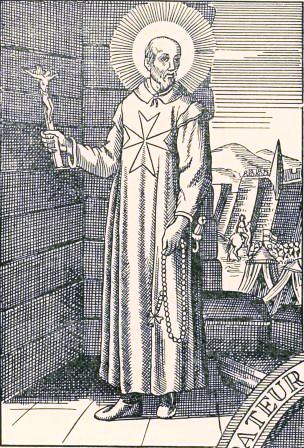The Blessed Raymond du Puis /
Raymond du Puy
Gérard's immediate successor was the Blessed Raymond du Puis. Born, it is said, in Dauphine, of a very old and very noble family-, which perpetuated itself through the Houses of Rochefort and Montbrun - or perhaps of Italian origin he certainly was related to that Adhémar du Puis who leas apostolic legate during the first crusade.
He was the first to assume the title of Master of the Hospital of Saint John of Jerusalem and gave a Rule to the Order, inspired by Saint Augustine's. It was he who introduced among the religious the triple division into chaplains, knights, and serving brothers. Only the second group had to belong to the nobility and be armed knights. From that time on, the brothers were no longer simply to be devoted to prayer ailed the care of the sick. Officially, since it was necessary in order to carry out the original and primary Work, they also had to fight the Infidel, to be soldiers in order to defend the Faith. The eight-pointed cross, which he ordered them to wear on their cloaks and garments, as well as armour, was the symbol of their pledge to remain in a state of crusade; that is, to follow without cease the examples of the martyrs by giving their lives to Christ. They were to fight manfully, armed with theological virtues, so as to practice later the works of mercy as a reward. For, he said to them, you must " love, revere, and preserve justice; favour, relieve, and defend the oppressed ".
Under his stewardship, the Hospital of Saint John was developed and filled with goods offered it for the support of the sick and the poor. Several Popes approved it and confirmed it in its aims and its Rulers in particular Innocent II whom in 1130, ordered that the red banner with a white cross be carried in battle.
Thus the Order became " the buckler of the Kings of Jerusalem ". The Knights took part in all the battles in Palestine, led by their Grandmaster and accompanied by mercenary soldiers. The blood of the brothers, like that of the Mohammedans, flowed abundantly. It was rare to see an Hospitaller made prisoner. Send if that happened, there was no need to ransom him, for he always died in torture rather than deny Christ.
'The Blessed Raymond counselled, incited, and urged on the crusaders for their greater success at the time of the affair of Ascalon, which ended in the capture of the city. But if he was ardent? - he was also prudent. At the siege of Tyre it was he who calmed the impatient army and prevented its spoiling the undertaking by an untimely impetuosity.
His image (which was painted on the walls of Saint John Decapitated, at Valletta on Malta together with those of the Blessed Gerard and the other saints of the Order) represents him dressed in the great ceremonial cloak with the white cross, sword at his side for he was a Knight and a rosary at his belt and a crucifix in his hand for he was a monk. In fact, he did not cease uniting prayer and "hospitality" to the defence of the Christian poor against the Infidel, for the triumph of the Faith and the honour of his crucified God.
He died about the year 1160, after having governed the Order for 33 years.
In these two superiors of the Hospital, the Founder and the First Master, we honour its creator and its organizer: two lucid spirits, two keen minds, who had the humility to use what already existed, to perfect it, and carry it to a greater efficiency. Store practical and realistic than mystical, they are nevertheless so by the supernatural aim they have set for themselves and by the prayer to which they devoted themselves constantly. They are men of action who have not grown old, for they saw and lived only what is eternal.
The text of this page is quoted from: Ducaud-Bourget, Msgr. François: The Spiritual Heritage of The Sovereign Military Order of Malta, Vatican 1958

- The second director of the hospital community: Raymond du Puy
- The Rule of the Order of St. John / Malta (by Raymond du Puy)
- The Rule of the Order of St. John of Jerusalem (by Raymond du Puy)
Page last modified on Monday, 20 October 2025 18:00:41
Back to the SMOM Page of the
![]()

Painting
in the Chapter Room of the Order of Malta at the Aventine Hill in Rome



























